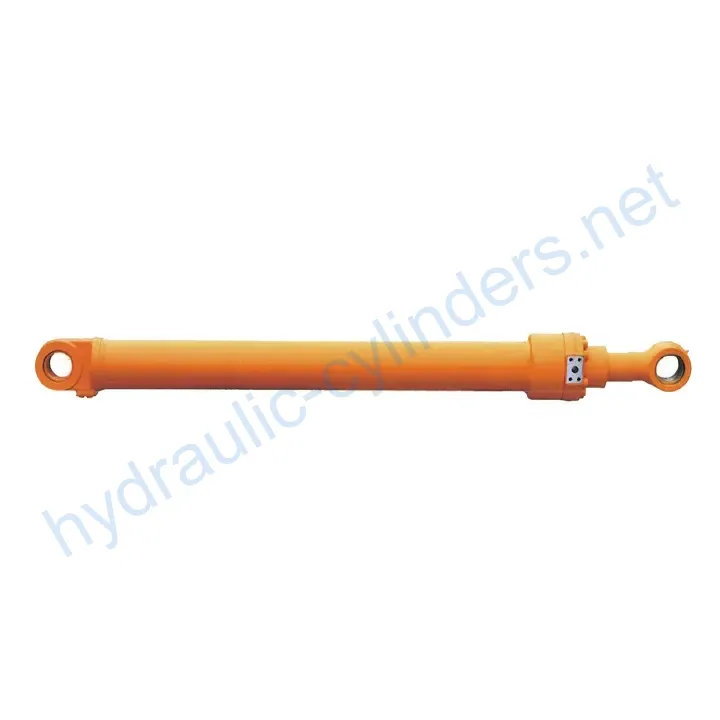Arm CylinderFor Sany Middle Excavator SY225C-9
Kot eden od proizvajalcev, dobaviteljev in izvoznikov hidravličnih cilindrov ponujamo hidravlične cilindre in številne druge izdelke.
Za podrobnosti se obrnite na nas.
Pošta:sales@hydraulic-cylinders.net
Proizvajalec, dobavitelj in izvoznik hidravličnih cilindrov.
Arm CylinderFor Sany Middle Excavator SY225C-9
Arm Cylinder, as the name suggests, is a specialized hydraulic cylinder designed to provide linear motion and power to the arm of various machinery, such as excavators, cranes, and robotic arms. It plays a crucial role in hydraulic systems, allowing for efficient movement and control of additional tools or attachments. These cylinders not only ensure smooth motion but also withstand heavy loads, ensuring the efficient operation and reliability of the machinery in various working conditions.

Features
- Efficient Power Transmission: The Arm Cylinder provides powerful linear motion and force, ensuring high-performance capabilities for the mechanical arm in various operations.
- Precise Control: Through the hydraulic system, the Arm Cylinder enables precise motion control, making operations with additional tools more flexible and accurate.
- Durability: Arm Cylinders are typically manufactured using high-strength materials, offering excellent wear and corrosion resistance, making them suitable for long-term use in harsh environments.
- Multi-functional Adaptability: These cylinders find wide applications in various machinery equipment, including excavators, cranes, and robotic arms, adapting to different work requirements.
- Ease of Maintenance: Designed with easy maintenance and replacement in mind, Arm Cylinders facilitate convenient regular inspections and maintenance, reducing equipment downtime.

Applications
Arm Cylinders are extensively used in the following industries:
- Construction Engineering: In excavators and cranes, Arm Cylinders control the movement of buckets or booms for earthwork, material handling, and structural installation.
- Manufacturing: In automated production lines, Arm Cylinders drive the motion of robotic arms for assembly, welding, and material handling processes, enhancing productivity and precision.
- Agricultural Machinery: Arm Cylinders control the movement of operating arms in agricultural machinery such as harvesters and seeders, carrying out tasks like seeding, fertilizing, and harvesting.
- Mining: In mining equipment, Arm Cylinders control the arm movement for mining and hauling of ore.
- Logistics and Transportation: Arm Cylinders are used in forklifts and handling robots to control the lifting and movement of forks, enabling material handling and stacking.
Design Considerations and Selection Criteria
When it comes to the design and selection of Arm Cylinders, several factors should be taken into account:
- Bearing Capacity: Arm Cylinders should be designed to handle the expected loads and forces in specific applications.
- Sealing: Various sealing components, such as piston seals and rod seals, made of wear-resistant materials like polyurethane and nitrile rubber, should be used to ensure effective sealing.
- Durability: The cylinder body and threaded ends should undergo precise treatment to enhance wear resistance and overall durability.
- Safety: Safety features should be incorporated into the design to prevent accidents and ensure operator protection during operation.
- Maintainability: Ease of maintenance and repair should be considered, allowing for quick and convenient inspections and replacements.

Sealing and Lubrication
To ensure effective sealing and lubrication, Arm Cylinders utilize various sealing components, such as piston seals and rod seals, made of wear-resistant materials like polyurethane and nitrile rubber. The cylinder body and threaded ends undergo precise treatment to improve wear resistance. Regular lubrication with appropriate hydraulic oil is necessary to maintain optimal performance.
Periodic Inspection and Preventive Maintenance
To ensure the longevity and reliable operation of Arm Cylinders, the following measures should be taken:
- Regularly inspect all components for signs of wear, damage, or leakage.
- Check and adjust the cylinder alignment and mounting to ensure proper functioning.
- Monitor and maintain the appropriate hydraulic fluid level and quality.
- Replace worn-out seals and other components promptly.
- Periodically clean and lubricate the cylinder to prevent contaminants and ensure smooth operation.
Correct Product Installation
Proper installation is crucial for the optimal performance and safety of Arm Cylinders. Follow these steps:
- Ensure the mounting surfaces are clean, flat, and free from any debris.
- Align the cylinder and mounting brackets accurately, using appropriate tools.
- Tighten all mounting bolts to the specified torque values.
- Check for any misalignment or binding after installation and make necessary adjustments.

Safety Considerations and Environmental Factors
When working with Arm Cylinders, safety measures are of utmost importance. Proper training should be provided to operators to ensure their well-being and prevent accidents. Environmental factors, such as temperature and exposure to corrosive substances, should also be considered to select the appropriate materials and ensure long-term performance.
Fault Diagnosis and Common Issues
Common issues that may occur with Arm Cylinders include leakage, reduced performance, and abnormal noise. To diagnose and address these problems:
- Inspect all seals and connections for signs of leakage.
- Check the hydraulic fluid level and quality.
- Verify the alignment and mounting of the cylinder.
- Listen for any unusual noise during operation.
For specific troubleshooting and solutions, consult the manufacturer’s guidelines or seek professional assistance to diagnose and resolve the issues effectively. Emphasize preventive measures to minimize potential problems.

Remember to organize the article logically, use subheadings for easy navigation, incorporate relevant images or charts to enhance understanding, and ensure the content is clear, concise, and suitable for readers with different levels of technical knowledge.
Author: lyl


Take a Tour of Our VR Factory:
Take a tour of our VR factory with the following
Hydraulic Cylinder Application:


